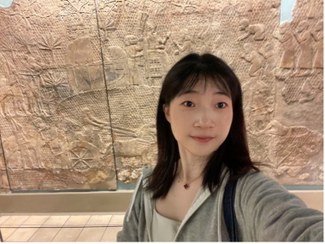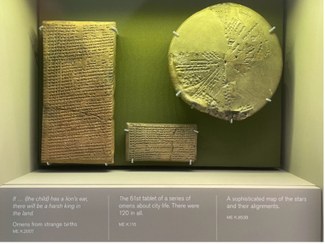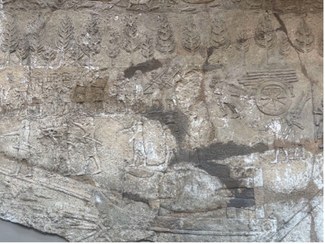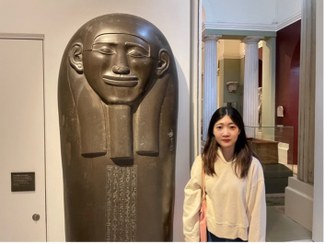Report from our 2023 Judith A. Lerner, Ph.D. Summer Traveler: Yu Song
ISAW is pleased to share the summer travel report from the 2023 Judith A. Lerner, Ph.D. Summer Travel Fund recipient, Yu Song.
I would like to express my sincere thanks to the Judith A. Lerner, PhD Summer Travel Fund, for the generous funds to support my travel in the UK. This opportunity enabled me to visit the British Museum and the Ashmolean Museum, as well as learn the materiality of cuneiform culture. I also want to convey my gratitude to Judith A. Lerner for her kind suggestions and warm help during this project.
My travel has three sections. The first one was to explore the craftsmen and labor management at Nimrud during the Neo-Assyrian period. I took two steps in this project. The first step was to collect visual representations of labor management or the working process in the British Museum. The iconography of craftsmen is rare, so I broadened the region to Nineveh and Assur. The outcome was that I established an image database of this theme. Based on the materials, craftsmen are depicted either in the monumental building process or in the military camp. Their appearance distinguishes them from other Assyrian officials. A great number of them are foreigners perhaps due to the war or the mass deportation.
The second step was to collect textual data from the "Cuneiform Texts from Nimrud" (CTN) series. I also built up my database (examples in the following pages). The texts show us, as the object being documented, craftsmen received rations in the wine lists. They are involved in debt or sold as slaves. In addition, they sometimes appear in the letters between the officials and the king, as labor force for the building projects of the empire.
Then I visited the collection of Ashurbanipal's library in the British Museum and read their publications on this topic. The British Museum has a long history of collecting and investigating Ashurbanipal's library. I paid more attention to the process of building such a library and the categories of this collection. The large number of divinatory texts in this collection infer a deep connection between divination and royal ideology.
I also use the iconography of Ashurbanipal to understand the relationship with Elam. Many reliefs during Ashurbanipal's reign depict his famous conquest of Elam, such as the battle of Ulai. On the one hand, the hostile relationship brings the defeat of Teumman and changes the political landscape of Mesopotamia. On the other hand, it leads to intense cultural communication during this period, as indicated in the Nimrud texts. Elamite craftsmen, especially singers are employed in the Assyrian court.
At the end of this project, I investigated the lexical lists from the archaic period to the Old Babylonian period in the Ashmolean Museum, Oxford. It contains a large number of tablets from Kish. During this period, Kish functions as an important point in the transmission of lexical lists from south Babylonia to the north and west. The lentil lexical lists indicate a school environment for the production of these exercise tablets.
Although most of the tablets are produced during the Old Babylonian period, there are several examples of earlier practice, such as the ED Lu A list and metal list during the Early Dynastic period. Compared to the famous Nippur collection, I learned a lot about the northern tradition of lexical lists here and the materiality of the school context.
I would like to express my thanks again to Judith A. Lerner, PhD Summer Travel Fund again, and to the support of ISAW. This trip was an important chance for me to explore my interests at an early stage of my doctoral study.
 Yu Song pictured with the relief of the South West Palace at Nineveh in the British Museum. The sitting figure is Sennacherib.
Yu Song pictured with the relief of the South West Palace at Nineveh in the British Museum. The sitting figure is Sennacherib.
 Part of the collection of Ashurbanipal’s library: omens and the map of stars.
Part of the collection of Ashurbanipal’s library: omens and the map of stars.
 Relief from the South West Palace at Nineveh, depicting the construction process.
Relief from the South West Palace at Nineveh, depicting the construction process.
 Yu Song pictured with the smiley face of the lid of the sarcophagus of Ptahhotepthe, at Ashmolean Museum, Oxford.
Yu Song pictured with the smiley face of the lid of the sarcophagus of Ptahhotepthe, at Ashmolean Museum, Oxford.